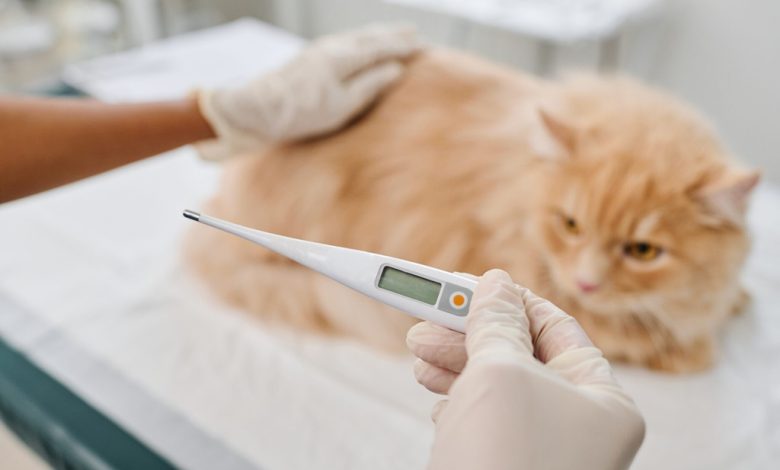How to Tell if Cat Has Fever?

As a cat owner, you want to ensure your feline friend is happy and healthy. One of the signs your cat may be under the weather is an elevated body temperature or fever. Recognizing when your cat has a fever is essential to keeping them comfortable and getting them the care they need. This comprehensive guide will walk you through everything you need to know how to tell if cat has fever.
What is Considered a Fever in Cats?
Cats’ normal body temperature ranges between 100°F and 102.5°F (37.8°C – 39.2°C). A temperature over 103°F (39.4°C) is considered a fever.
Kittens tend to have slightly higher body temperatures than adult cats, ranging from 100°F to 103°F (37.8°C – 39.4°C). So, a temperature over 103°F in a kitten could indicate a fever.
Cats are very good at hiding illness. So, by the time you detect a fever, your cat may have been dealing with an elevated temperature for some time already. A temperature of 104°F (40°C) or higher indicates a significant fever and requires prompt veterinary attention.
Checking Your Cat’s Temperature
You’ll need a rectal thermometer explicitly designed for pets to accurately read your cat’s temperature. You can purchase one at any pet supply store or online retailer. Here are some tips on taking your cat’s temperature:
- Place a small amount of petroleum jelly on the bulb end of the thermometer to help it glide smoothly.
- Hold your cat in your lap or steady them against your body. Gently lift their tail and insert the thermometer about 1 inch into the rectum.
- Please wait until you hear the thermometer beep, indicating it’s finished reading, usually within 60 seconds.
- Carefully remove the thermometer and check the reading. Be sure to clean the thermometer thoroughly between uses.
- It can help to have someone assist you in restraining the cat during temperature readings. Stay calm and offer treats afterward.
Taking a rectal temperature gives the most accurate reading. Ear and forehead thermometers designed for pets are also available but may be less reliable. Oral temperature taking is difficult with cats and is not recommended.
If your cat seems distressed by having their temperature taken, contact your vet for guidance. Never force the process if it causes extreme upset.
Signs of Fever in Cats
In addition to checking for an elevated temperature, look for these common signs of fever in cats:
Changes in Behavior
- Lethargy – Laying around more than usual, lack of interest in toys or activities
- Hiding – Spending more time tucked away under furniture or in closets
- Loss of appetite – Not eating as much despite food being available
- Seeking warmth – Curling up near heat vents or tucked under blankets
- Shivering – Body tremors indicating chilling
- Lack of grooming – Unkempt, matted fur from not self-grooming
Changes in Appearance
- Warm, dry nose – Usually feels moist and cool
- Flushed ears or gums – Reddened color to ears, gums, or inner eyelids
- Fast or difficult breathing – Breathing rate over 40 breaths per minute at rest indicates distress
- Dilated pupils – Pupils remain excessively enlarged even in bright light
- Discharge – Watery eyes, runny nose, drooling, or coughing up fluid
How the Cat Feels
- Hot to touch – Feels warmer than usual when you pet them
- Tense muscles – Feels stiff and tight when handled versus relaxed
- Sensitivity – Pulls away or hisses when touched as if sore
If your cat displays several of these fever signs in combination with reduced activity, it’s a good indication they are running a temperature. Contact your vet right away when these symptoms appear. An immediate exam will identify if there is an underlying illness causing the fever.
Causes of Fever in Cats
Some common health issues that can cause a fever in cats include:
Infection
Upper respiratory infections, abscesses, and urinary tract infections involve bacterial invasions that trigger an immune response and fever. Infections require antibiotics and professional treatment.
Inflammation
Arthritis, pancreatitis, and inflammatory bowel disease cause inflammation that can spike a fever. Anti-inflammatories and other medications are needed.
Cancer
Cancers like lymphoma and leukemia suppress the immune system and leave cats prone to fevers. Diagnostic testing, like biopsies, is needed to determine treatment.
Reaction to Medication
Allergic reactions or side effects from medications, vaccines, anesthesia, and drugs can sometimes cause cat fevers. Treatment involves stopping the medication and supportive care.
Dental Disease
Abscessed or infected teeth and gums harbor bacteria. The infection enters the bloodstream and causes system-wide effects like fever. Dental cleaning and tooth extraction solve the problem.
Trauma
Injuries like burns, wounds, or fractures allow bacteria into the body, leading to infection and fever. Wound care and antibiotics treat the root cause.
Heat Stroke
In hot weather, cats can overheat if left without shade or cooling. This causes the body temperature to spike to dangerous levels very quickly. Rapid cooling and hydrating bring the fever down.
Some causes, like upper respiratory infections and pancreatitis, are more common. Others, like cancer and heat stroke, are rarer but still require prompt care. Diagnostic tests like bloodwork, cultures, x-rays, and biopsies help identify the underlying cause. Treating the fever’s source is critical to restoring your cat’s temperature.
When to See the Vet
Contact your veterinarian immediately if your cat has a temperature over 103°F (39.4°C) or shows lethargy and other fever signs. A high fever can lead to seizures and organ damage and even become life-threatening without prompt treatment.
Kittens with temperatures over 103°F (39.4°C) should be evaluated immediately since their immune systems are still developing. Saying “better safe than sorry” definitely applies to our feline friends!
Even mild fevers in cats warrant a call to the vet, as they could indicate:
- Early stages of infection
- Chronic conditions worsening like kidney disease
- Reaction to a medication, toxin, or insect bite
Monitoring for improvement at home is okay for low-grade fevers without other symptoms. But follow up with your vet within a day or two if it persists.
Get emergency care right away if your cat has:
- Temperature over 104°F (40°C)
- Breathing distress like panting or wheezing
- Blue gums or tongue
- Difficulty walking or disorientation
- Seizures
These signs indicate a medical crisis requiring hospitalization and intensive treatment. Don’t delay care, as it could be life-saving!
Caring For a Cat With a Fever
While waiting for your vet appointment or hospital visit, focus on keeping your feverish feline comfortable:
- Encourage rest: Provide a quiet, darkened space with soft bedding and minimal disturbances. Sleep aids the healing process.
- Offer easy access to food and water: Dehydration and hunger pangs will worsen your cat’s feelings. Use shallow dishes within easy reach.
- Monitor bathroom habits: Lack of urination or other litter box issues could indicate worsening illness—track activity.
- Use cool compresses: Place soft towels soaked in cool water on the inner thighs and neck to aid cooling.
- Brush frequently: Removing excess fur helps prevent overheating. But keep sessions brief to avoid exhaustion.
- Avoid covers and cuddling: Don’t bundle or hold your febrile kitty too close. The extra body heat can further increase its temperature.
- Check temperature hourly: Monitoring for improvements or declines will help guide care—log readings to inform your vet.
- Confirm medications are given: Complete any treatments your vet prescribes fully and on schedule for best results.
With attentive home nursing and your vet’s treatment plan, your feverish feline companion will return to total health before you know it!
In Conclusion
A fever in cats should never be ignored, as it signifies an underlying illness that needs attention. Check your feline’s temperature at home and watch for other sick symptoms to identify when they feel under the weather. Have your vet examine any cat with a temperature over 103°F (39.4°C) or who displays worrisome behavior changes. Addressing the cause of the fever quickly can help your beloved pet feel better! With attentive care and treatment, your furry friend will be fever-free and back to total health in no time.
FAQs
Q: Can cats have fevers without other symptoms?
A: Cats can develop a fever without initially showing other signs of illness. Since cats are adept at masking sickness, an isolated fever could indicate internal illness. Monitoring temperature and looking for additional symptoms is wise when a fever is detected.
Q: What temperature is dangerous for a cat?
A: Temperatures above 104°F (40°C) are considered dangerous for cats and require emergency medical care. Sustained temperatures between 103°F – 104°F (39.4°C – 40°C) are severe and need prompt vet attention as well.
Q: When should I take my cat to the ER for a fever?
A: Rush to emergency veterinary care if your cat has a temperature over 104°F (40°C) and signs of breathing distress like panting, wheezing, or pale/blue gums. Also, seek ER care if they are having seizures, show extreme lethargy, cannot walk, or seem confused/disoriented. These indicate a medical emergency requiring intensive treatment and 24/7 monitoring. Don’t delay getting help; it could save your cat’s life.
Q: Can I give my cat Tylenol for a fever?
A: Tylenol (acetaminophen) and other human fever reducers can be highly toxic to cats and must be avoided. Only use medication specifically prescribed by your veterinarian to reduce your cat’s fever. Some vets may recommend non-steroidal anti-inflammatories, but check with your vet before giving anything. Cool water compresses are a safe fever treatment at home.
Q: How long can a cat fever last?
A: The duration of a cat fever varies depending on the underlying cause. Bacterial and viral infections can cause fevers lasting 1-2 weeks. Fevers from trauma, medication reactions, or unknown causes typically resolve within 2-3 days. If your cat’s fever continues beyond three days without explanation, recheck with your vet for further instructions.



